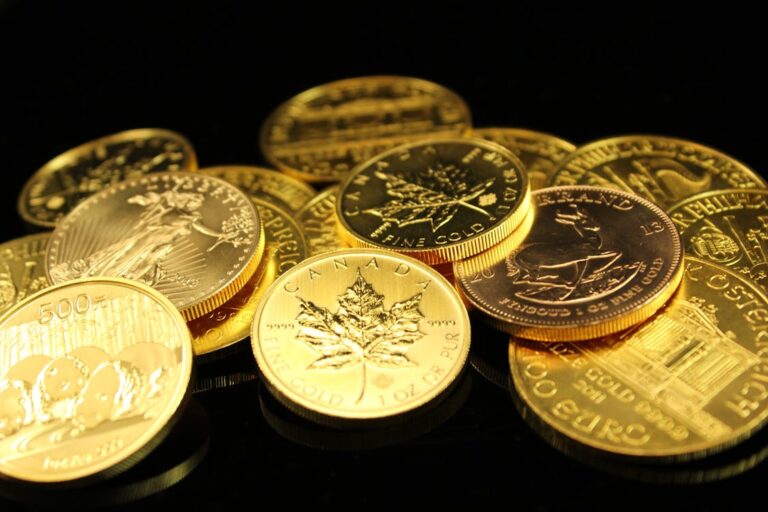What is Graded Coins? Understanding MS and PF Grading and Their Value for Collectors
Many people collect coins not just for their beauty but also for their value. Graded coins are coins that have been assessed and certified for their condition. MS (Mint State) and PF (Proof) are two main types of coin grading. MS coins are issued for general circulation, while PF coins are made for collectors with sharper details and a mirror-like finish.
Graded coins often hold higher collectible value for stackers, who are individuals collecting precious metal items like coins. Coin grading helps in determining a coin’s worth, making it a valuable tool for both beginners and experienced collectors.
Understanding the differences between MS and PF grading can help collectors make informed decisions. Each grade affects a coin’s market value and desirability. Knowing these details can enhance your coin collecting experience and investment.
Key Takeaways
- Graded coins have been certified for their condition.
- MS coins are typically for circulation, while PF coins are for collectors.
- Grading affects a coin’s value and helps stackers collect valuable items.
Understanding Coin Grading
Coin grading evaluates the physical condition of a coin and assigns it a grade. This process uses both numerical and adjectival grades to determine a coin’s quality and value.
The Basics of Coin Grading
Coin grading is a system to determine the condition of a coin. It assesses aspects like wear, luster, strike, and eye appeal. Wear refers to the loss of metal due to handling. Luster indicates the shine of the coin, and strike evaluates how well the coin’s design is imprinted. Eye appeal is about the overall look.
Coins are graded to help collectors and investors know the value and rarity. Grading is performed by experts who assign grades to coins after careful examination. Certified grades ensure consistency and reliability. This information is essential for buying or selling coins.
The Sheldon Scale and Adjectival Grades
The Sheldon Scale is a numerical grading system used to grade coins. It ranges from 1 to 70, with 1 being the lowest grade (Poor) and 70 the highest (Perfect). Developed in the 1940s by Dr. William Sheldon, it adds precision to coin grading.
| Grade | Description |
|---|---|
| 1 | Poor |
| 20 | Very Fine |
| 40 | Extremely Fine |
| 60-70 | Mint State (MS) |
Adjectival grades are terms like Fine, Very Fine, or Brilliant Uncirculated. These help describe the coin’s appearance more plainly. Combining numerical and adjectival grades helps clearly define a coin’s condition.
Professional Coin Grading Services
Professional Coin Grading Service (PCGS) and Numismatic Guaranty Corporation (NGC) are leading coin grading companies. They provide certification services, giving collectors and investors confidence in the coin’s grade. This certification process involves professionals examining coins using strict grading standards.
Certified coins by PCGS or NGC often have higher market value. The certification includes a detailed evaluation, tamper-proof holder, and a unique identification number. This ensures the coin’s grade is not tampered with or altered, maintaining its integrity for buyers and sellers.
Professional grading services have set the standard in the coin collecting industry, ensuring a consistent, reliable grading system.
Mint State (MS) vs Proof (PF) Coins
Knowing the difference between Mint State (MS) and Proof (PF) coins can help collectors and enthusiasts identify the value and quality of their coins. Both types have distinct characteristics that set them apart.
Defining Mint State Coins
Mint State (MS) coins are those that have never been in circulation. They are produced using standard process and have no wear from handling. These coins go from the mint straight to collectors or dealers.
Key points:
- Uncirculated: They are typically called “uncirculated” because they have not been used in daily transactions.
- Luster: They often have an original mint luster, making them attractive to collectors.
- Grades: These coins are graded on a scale from MS-60 to MS-70, with MS-70 being a perfect coin with no imperfections.
Attributes of Proof Coins
Proof (PF) coins are specially made using a unique minting process. They are struck multiple times to ensure high detail and a polished finish. Proof coins are often used for commemorative purposes and can be very beautiful.
Key points:
- Striking Process: This involves striking the coin more than once, giving it a sharp, detailed appearance.
- Finish: They often feature a mirror-like surface with frosted designs, known as a cameo or ultra cameo.
- Grades: Grading for proof coins ranges from PF-60 to PF-70. Like MS coins, a PF-70 is flawless.
- Appearance: Some proof coins exhibit a “deep cameo” (DCAM) or “ultra cameo” (UCAM) effect.
Contrasting MS and PF Grading
Grading Mint State (MS) and Proof (PF) coins involves careful evaluation. While both types are graded on a scale of 60 to 70, their features and intended uses differ.
Key points:
- MS Grading: Focuses on the luster, strike, and absence of bag marks or abrasions.
- PF Grading: Emphasizes the depth of the mirror-like finish and the quality of the cameo effect.
- Usage: MS coins are often uncirculated examples from regular runs. PF coins are intended for collectors and not for circulation.
- Market Value: Proof coins generally carry a higher premium due to their intricate manufacturing and appearance.
Understanding the specific characteristics and grading criteria for both Mint State and Proof coins can help you make informed decisions in coin collecting.
The Value and Collectibility of Graded Coins
Graded coins hold significant value and appeal to collectors due to their certified condition, rarity, and potential investment returns. Their market value can fluctuate based on demand, historical importance, and the coin’s grade assigned by reputable organizations.
The Market for Graded Coins
The market for graded coins is robust and diverse, attracting various types of collectors and investors. Coin dealers, auction houses, and online platforms are some places where these coins are bought and sold. The prices for graded coins depend on the coin’s grade, rarity, and demand at a given time.
Collectors often seek coins graded by reputable organizations like the Numismatic Guaranty Corporation (NGC) and the American Numismatic Association (ANA). These certified coins provide assurance on the coin’s authenticity and condition, increasing their market value. Modern coins, as well as older ones, can carry significant premiums if they are in high grades.
Factors Influencing Value and Demand
Several factors influence the value and demand for graded coins. Rarity plays a crucial role; rare coins are often more sought after. Precious metals content, such as silver and gold, also impacts their market value. The coin’s grade, determined by its physical condition, affects how much collectors are willing to pay.
Other specific features like full bands, full bell lines, and attractive toning can enhance a coin’s collectible value. Professional grading ensures these aspects are accurately assessed. Demand is further driven by historical significance, coin variety, and market trends, making certain coins especially appealing to collectors and investors alike.
Additional Details in Graded Coins
Graded coins have unique attributes that add value and appeal for collectors. These include special designations, identifying flaws, and the importance of encapsulation.
Understanding Special Designations
Special designations can significantly impact a coin’s value. For instance, a coin might receive a “star designation” from NGC if it has exceptional eye appeal. Coins with a “SP” or “Specimen” label indicate that they were specially struck and have qualities different from regular circulation coins.
Numerical grades like MS-70 or PR-70 denote a perfect coin with no visible flaws. Strike characters such as “FS” for Full Steps on Jefferson Nickels pinpoint specific details on the coin that were fully struck.
Identifying Flaws and Blemishes
Identifying flaws and blemishes is crucial in coin grading. Flaws such as scratches, nicks, or any marks can reduce a coin’s grade. Coins free of such defects, or “gem” coins, often fetch higher prices.
Toning refers to the color change on the coin’s surface, which can be natural or due to improper storage. Natural toning is often valued, while artificial toning may negatively affect the coin’s grade. Cleaning a coin can be detrimental too, as cleaned coins generally receive lower grades.
The Significance of Encapsulation
Encapsulation is the process of sealing a coin in a protective holder. It provides safety against environmental damage and preserves the coin’s condition. Encapsulated coins are also easier to trade and are considered more reliable investments.
Additionally, the strike quality and mintmark are essential details sealed with the coin. For example, a perfect-strike coin like an MS-70 encapsulated by a major grading service holds higher credibility.
The American Silver Eagle encapsulated and graded becomes a sought-after collectible. Moreover, encapsulation helps identify the variety and coin types, which is crucial for United States coins.
Frequently Asked Questions
Graded coins can be classified using specific scales (MS for Mint State and PF for Proof). These scales help determine a coin’s condition and value.
How does the MS coin grading scale classify the condition of coins?
The MS (Mint State) scale ranges from MS60 to MS70. MS60 describes coins with noticeable flaws but no wear. MS70 indicates a flawless coin with no visible imperfections under 5x magnification.
What distinctions are made between PF and MS graded coins?
PF (Proof) coins are specially minted with high-quality surfaces for collectors, while MS (Mint State) coins are regular circulation coins. PF70 indicates a perfect Proof coin, while MS70 is a perfect Mint State coin.
What are the implications of an MS-65 grade on a coin’s value and condition?
An MS-65 coin has strong luster and eye appeal with few marks or hairlines. It is in excellent condition and often valued higher than lower-graded coins because it is closer to perfection.
In coin collecting, how does the PF grading scale differ in criteria from the MS scale?
The PF (Proof) grading scale, like MS, ranges from 60 to 70. However, PF grades focus on proof-specific qualities like mirror finish and strike quality. MS grades focus on the preservation of normal circulation coins.
Can you outline the steps to grade coins at home with accuracy?
To grade coins at home:
- Use good lighting and magnification.
- Compare the coin to reference pictures.
- Check for wear and flaws.
- Note the coin’s luster and strike.
- Use a grading book or online resource to assign a grade.
Is an MS70 or PF70 grade higher in terms of quality and collectibility?
Both MS70 and PF70 represent the highest quality for their categories. MS70 is perfect for Mint State coins, and PF70 is perfect for Proof coins. Both are highly collectible due to their flawless condition.



